About foot pain
Musculoskeletal foot pain refers to discomfort or injury affecting the bones, muscles, joints, tendons, or ligaments in your feet. These structures work together to support your body and allow movement, so when something goes wrong it can lead to pain that affects your daily life. This page will guide you through some of the most common causes of foot pain, what symptoms to look out for and provide some advice on how to self-care.
If you have bunions, big toe pain or heel pain please follow the self-care advice for 3 months. If this has not helped you can self-refer to podiatry all the information can be found here.
getUBetter app
One way to help yourself is to use the getUBetter app.
This free app can support you to manage your musculoskeletal condition.
Benefits of the app include:
- 24/7 support approved by local clinicians
- Easy to follow exercises
- Support to recover, live and work well
- Help when on a waiting list
- Advice on when to seek help from a GP
- Access to local treatments and services
- Support for managing persistent pain
- It’s free, and available via mobile app and through any web browser
Search ‘getUBetter’ in your app store or visit the website
Toes and middle of foot
Hammer toes advice
Hammer toes advice
Toe pain
There are lots of causes of toe pain. You can usually ease the pain yourself. But see a GP if the pain does not improve.
How to ease toe pain yourself
If you see a GP about toe pain, they’ll usually suggest trying these things:
Do
- rest and raise your foot when you can
- put an ice pack (or bag of frozen peas) wrapped in a towel on your toe for up to 20 minutes every 2 to 3 hours
- wear wide comfortable shoes with a low heel and soft sole
- use painkillers such as paracetamol or ibuprofen gel (or ibuprofen tablets if needed)
- buddy strap a broken toe, put a small piece of cotton wool or gauze between your sore toe and the next toe, and use tape to loosely strap it up (do not do this for a big toe or a badly broken toe)
- try regular gentle stretching exercises
Don’t
- do not walk or stand for long periods
- do not wear high heels or tight pointy shoes
A pharmacist can help with toe pain
If you have toe pain, a pharmacist can advise you about:
- the best painkiller to take
- insoles and pads for your shoes
- treatments for common skin and nail problems
- if you need to see a GP
See a GP if:
- pain in your toe is stopping you doing normal activities
- the pain is getting worse or keeps coming back
- the pain has not improved after treating it at home for 2 weeks
- you have diabetes and foot pain, foot problems can be more serious if you have diabetes
What we mean by severe pain
Severe pain
- Always there and so bad it’s hard to think or talk
- You cannot sleep
- It’s very hard to move, get out of bed, go to the bathroom, wash or dress
Moderate pain
- Always there
- Makes it hard to concentrate or sleep
- You can manage to get up, wash or dress
Mild pain
- Comes and goes is annoying but does not stop you doing daily activities
Go to an urgent treatment centre or A&E if:
- you have badly hurt your big toe
- you’re in severe pain
- you feel faint, dizzy or sick from the pain
- you have any tingling or loss of sensation in your foot
- your toe is pointing at an odd angle
- you heard a snap, grinding or popping noise at the time of injury
- you have difficulty moving your toes or you cannot walk
Causes of toe pain
A sore toe is often caused by exercising too much or wearing shoes that are too tight.
Your symptoms might also give you an idea of what’s causing your toe pain.
| Symptoms | Possible cause |
| Pain or swelling around the nail, nail curls into the toe | Ingrown toe nail |
| Hard bony lump near the big toe | Bunion |
| Pain, tingling and numbness when you’re cold or stressed, toes can change colour | Raynaud’s or chilblains |
| Pain, swelling, red or bruised toe, hurts to walk | Broken toe |
| Sudden pain, stiffness, red or hot swollen skin around the toe joint | Gout |
Big toe pain
Big toe pain
The big toe joint is a common sight of pain and osteoarthritis in the foot.
- The big toe joint can become painful and movement can reduce through time.
- Most people will find that their pain can be managed with the following advice which will include information on the best footwear to use.
All people with big toe joint pain are asked to complete self-help treatment before making a referral to Leeds Community Podiatry.
Signs and symptoms of big toe joint pain
You may experience any, or all, of the following:
- Pain, usually felt on the top of your big toe joint, more so with increased activities
- A reduced ability to bend your toe
- Bony thickening and swelling of the big toe joint
- A hard bony lump may form over the top of the big toe joint which can cause pain if this rubs in shoes that are too shallow.
- Numbness and tingling if the bony lump presses on a nerve.
X-rays are not usually required to know you have arthritis of the big toe.
For more information on osteoarthritis please visit NHS: Osteoarthritis or NHS Lanarkshire : Hallux Limitus and Rigidus (Osteoarthritis)
What you can do to manage your big toe joint pain?
Making simple changes to your lifestyle can help improve your big toe joint pain
- Rest your foot as much as you can and raise your foot whilst seated
- Reduce activities that make your pain worse
- Consider exercises such as swimming that places less demands on your painful joint
- Apply an ice pack to the painful area (or ice cubes/frozen peas wrapped in a towel) This can be apply for up to 20 minutes, up to 3 times per day
- Pain or anti-inflammatory medication may help. Please consult your GP or the pharmacist at your local chemist before taking medication.
- If you are overweight, reducing weight can help with foot pain
- Smoking can reduce the body’s ability to heal so, if you are a smoker, it will help to stop
Footwear choices
- Avoid tight fitting, narrow and pointed shoes
- Try a shoe with a firm, thick, curved sole
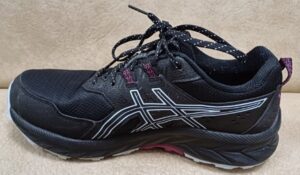
What happens next
Continue following the above advice for 3 months and you may find that your pain improves.
If your pain is the same or worse, continue with the above advice and refer yourself to podiatry.
Please complete the referral form and once you have completed the form, please email the form and the photo to the Podiatry department on leedscommunitypodiatry@nhs.net
Bunions
Bunions
Bunions (or Hallux valgus) occur when the big toe moves towards the second toe and causes a bony lump to form on the inside of your foot.
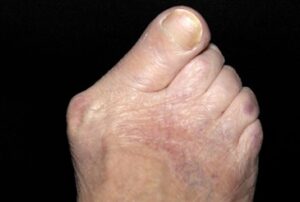
A fluid filled swelling can form over the lump which can become swollen (bursitis). Bunions are very common. Most people can live with them without needing treatment.
All people with bunions are asked to complete self-help treatment before making a referral to Leeds Community Podiatry.
What is the outlook for bunions? Will the pain go away
You cannot get rid of bunions yourself but there are things you can do to help the pain. For more information please visit NHS: Bunions or NHS Lanarkshire: Hallux Valgus (Bunions)
What can you do to help your bunions?
Footwear choices
- Avoid high-heels or tight, pointy shoes
- Choose a wide shoe with a deep toe box that has an adjustable fastening
- Don’t thread the bottom lace holes

Pain relief
- See a pharmacist at your local chemist who can advise on pain and anti-inflammatory medication.
- Try bunion protectors and pads, you can buy these at your local chemist.
- Try taking steps to lose weight if you are overweight
Exercises
Using a looped elasticated band, place this around your big toes, widen the feet to stretch the toes straighter and then lift the big toes up and down for 3 to 5 minutes, 2 to 3 times a day. Shop for a lightweight resistance band if you do not have anything suitable at home like a thick rubber band.

After 3 months of trying the advice every day
- Pain relief
- Exercises
- Shoes
If your pain is the same or worse, continue with the advice.
Please complete the referral form and once you have completed the form, please email the form and the photo to the Podiatry department on leedscommunitypodiatry@nhs.net
Neuroma
Neuroma
What is Morton’s neuroma?
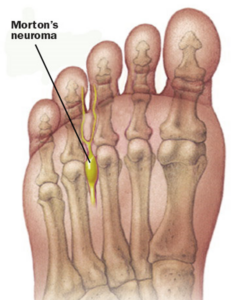
It is a condition that affects the toe nerves in the forefoot. The nerves may be affected because they are being compressed and can become enlarged. This may be as a result of swelling (usually bursitis) or thickening of the sheath around the nerve (neuroma), both of which result in similar symptoms and treatment. Morton’s neuroma is sometimes called Morton’s metatarsalgia or interdigital neuroma.
Morton’s neuroma causes pain and numbness in the third and fourth toes. It can also affect the nerve between other adjacent toes.
It tends to affect only one foot. You can have more than one neuroma in the same foot.
What causes Morton’s neuroma?
The exact cause of Morton’s neuroma is not known. However, it is thought to develop as a result of long standing (chronic) irritation of the nerve. There are a number of things that are thought to contribute to this. Some thickening (fibrosis) and swelling may then develop around a part of the nerve. The bones of the foot are also thought to contribute to the development of Morton’s neuroma as there is limited space between the long bones of the foot (metatarsals), where the nerves lie. This means that the nerves are more likely to be compressed and irritated when wearing narrow shoes which can therefore make the problem worse.
Sometimes, other problems can contribute to the compression of the nerve. These include the growth of a fatty lump (called a lipoma) and also the formation of a bursa (a fluid-filled sac that can form around a joint). Also, inflammation in the joints in the foot next to one of the digital nerves can sometimes cause irritation of the nerve and lead to the symptoms of Morton’s neuroma.
Who gets a Morton’s neuroma?
About three-quarters of people with Morton’s neuroma are women. It commonly affects people between the ages of 40 and 50 but can affect someone of any age.
Poorly fitting or constrictive shoes can contribute to Morton’s neuroma. It is more likely in women who wear high-heeled shoes for a number of years or men who wear constrictive shoe.
What are the symptoms of Morton’s neuroma?
People with Morton’s neuroma usually complain of pain that can start in the ball of the foot and shoot into the affected toes. However, some people just have toe pain. There may also be burning, tingling and numbness of the toes. Your affected toes may also appear to be spread apart. The symptoms are usually felt in the space between two toes and it can hurt to press in this area or when you squeeze the metatarsals together.
For example, if the nerve between the third and fourth metatarsal bones is affected, the symptoms will usually be felt up the right-hand side of the fourth toe and up the left-hand side of the third toe. Some people describe the pain that they feel as being like walking on a stone or a marble.
The pain is relieved by taking your shoe off, resting your foot and massaging the area.
How is Morton’s neuroma diagnosed?
Morton’s neuroma is usually diagnosed by your podiatrist, GP or other health professional based on your symptoms and from an examination of your foot. There are certain cases where a scan may be needed to help with the diagnosis, particularly if standard, initial treatments have not offered a satisfactory level of improvement.
What is the treatment for Morton’s neuroma?
- Footwear adjustments: This includes avoiding of high-heeled shoes, over tightening shoe laces, narrow shoes or a pointed toe box. We would recommend wide shoes that are rounded at the toe box.
- Insoles: Metatarsal pads can be provided that can reduce the pressure in the forefoot.
- Injections: Steroid, local anaesthetic or a combination of the two, are deposited into the affected area of the forefoot.
- Surgery involves a small incision (cut) being made on the top of the foot between the affected toes. The surgeon will then either create more space around the affected nerve (known as nerve decompression) or will resect (cut out) the affected nerve. If the nerve is resected (cut out), there will be some permanent numbness of the skin between the affected toes.
What is the outlook for Morton’s neuroma?
About half of all people find their symptoms can be controlled with footwear modification and insoles, and 60 to 80% benefit from injections. Of those who choose to have surgery, approximately 80 to 90% will do well. Symptoms can recur after both injections and surgery. Complications can occur after surgery which can include continued, or possibly increased, pain.
Middle foot pain
Middle foot pain
What causes pain on the top of the foot?
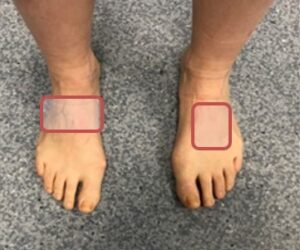
Pain in the top of the foot (midfoot area, see picture) affects around 20% of people over the age of 50. It is usually associated with pain during activities like walking and standing and can sometimes be painful at night.
The most common underlying cause of pain is osteoarthritis, followed by tendon pain and sometimes ligament pain. Pain can occur after a fall, a sprain or overdoing it, for example after long walk or wearing shoes you are not used to.
What problems can be expected?
Most people report pain and difficulty with daily activity (walking and standing), some people the pain occurs with sports and running. Pain can be aggravated by tying the shoes too tight or wearing shoes with a high heel.
What is the treatment?
Medication
If you have regular pain, painkillers such as paracetamol or ibuprofen may help, please see your local pharmacist for advice.
Weight loss
Carrying extra pounds around your waist can put extra strain on your feet. Reducing your body weight can help. Losing just 5 pounds of body weight can improve foot pain.
Footwear
Wearing good footwear may help to ease symptoms of pain and discomfort. Shoes with thicker soles can help such as, running style trainers or a walking style shoe or boot.
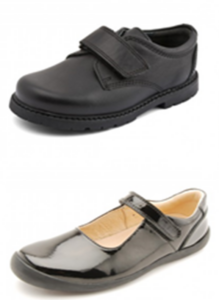
Footwear should fit correctly to avoid the rubbing on the top of the foot causing pain (Velcro may help). The shoe should be wide and rounded at the front of the foot and deep enough for your toes to move freely. Avoid wearing shoes that make the problem worse, such as high-heeled, pointed or tight shoes.
You may find that shoes with laces or straps are best, as they can be adjusted to the foot. It is preferred that the shoe material is soft, stretches or is elasticated.
Lacing
Lacing the shoe differently can help create more room at the toe box. Missing out the lace holes at the in the middle of the shoe may help.
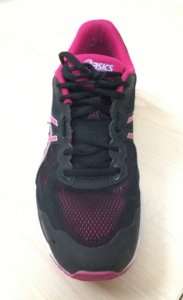
How can a podiatrist help?
Insoles
Podiatrists can offer additional treatments. Insoles may be considered and have been shown to help with reducing foot pain.
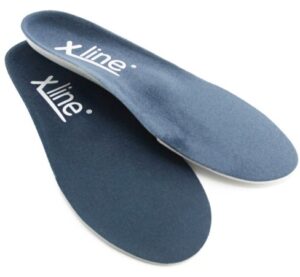
Insoles tend to work best if you have flat feet or if you have noticed that your arches have dropped. Insoles take up more room in the shoe and sometimes this can lead to discomfort and pressure onto the foot from the shoe.
Exercises
Stronger muscles has been shown to help arthritis pain, therefore we may suggest exercises to help strengthen your foot and ankle. You may like to try just doing gentle heel lifts on both feet (around 1 inch or 2 cm high) 10 to 20 times a day, if this is painful try doing sitting first and work your way up to standing.
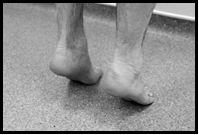
Steroid injections
A podiatrist can assess whether a steroid injection would be appropriate. Your podiatrist will explain what this would involve and what the risks, benefits and limitations can be. In most cases, a podiatrist can provide this injection. Sometimes we may recommend that the injection is performed whilst you have an ultrasound scan. This would require a referral onto a specialist.
Surgery
A surgical referral depends on what has been tried such as footwear and insoles, the stage of the arthritis, the pain levels and the long term impact on your quality of life. If surgery may be required, your podiatrist can discuss this with you and can arrange a referral to an orthopaedic department for an opinion.
Exercise videos
Foot arch exercise
Intrinsic towel exercise
Standing double heel raises
Bottom of foot
Heel pain
Heel pain
Heel and arch pain (Plantar Fasciitis)
This is the most common condition affecting the foot; affecting 1 in 10 people.
- Heel pain is more likely to occur and re-occur if you have a standing job, an active manual job and or you carry excess body weight.
- Most people will find that their pain will settle by following advice and by performing some simple exercises.
All people with heel pain are asked to complete self-help treatment before making a referral to Leeds Community Podiatry.
What is the plantar fascia and what causes plantar fasciitis?
The plantar fascia is a strong band of tissue which supports, and shock absorbs in the arch. Heel pain occurs when this tissue changes over time and gets thicker.
Signs and symptoms of Plantar heel pain
You may experience any or all the following:
- a gradual onset of pain affecting the base of the heel
- pain in the heel during the first steps when you get out of bed in the morning
- pain in the heel when weight bearing after a period of inactivity or rest
- pain that eases or lessens with moderate activity
- worsening pain later during the day or after long periods of standing or walking
What is the outlook for heel pain? Will the pain go away
At least half of all people with heel pain get better within 6 to 9 months with or without treatment. Pain will usually improve quicker if you follow some of the advice in this leaflet.
For more information please visit NHS: Heel pain or NHS Lanarkshire: Plantar heel pain
What can you do to help your heel pain?
- Rest your feet and take breaks at work
- Spend less time running, standing and stand on softer surfaces
- Wear good footwear EG trainers with a thick sole and support
- Taking positive steps to reduce your body fat
Footwear choices to speed recovery

Choose
- Footwear with laces or Velcro fastening
- Heel of up to 2 inches (5cm)
- Proper running or walking trainer
Avoid
- Walking barefoot on hard surfaces.
- Worn out shoes or old sloppy slippers
- Very flat shoes (slippers and sandals, plimsolls, pumps, flip-flops)
Daily exercises
Helping your morning pain
Stretch and hold for 1 to 2 minutes.
You may want to go straight into comfortable shoes on standing.
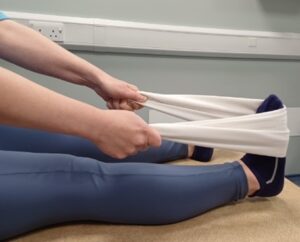
Stretching exercises
People who have heel pain tend to have tight leg muscles. Calf stretches aim to help prevent pulling and pain at the heel. Hold a stretch for 30 seconds. Try these morning, lunch and evening like in the photo.
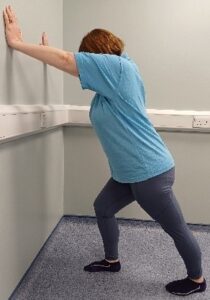
Strengthening exercises
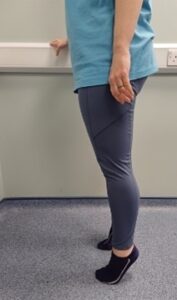
Strengthening your leg and foot muscles can help your heel pain. Try rising onto your tip toes and slowly lowering to the ground.
Try these movements 10 to 20 times each day.
Plantar fascia towel stretch
Standing double heel raises
After 3 months of trying the advice every day
- Increasing rest
- Exercises
- Shoes
If your pain is the same or worse, continue with the advice.
Please complete the referral form and once you have completed the form, please email the form and the photo to the Podiatry department on leedscommunitypodiatry@nhs.net
Ball of foot pain
Ball of foot pain
What causes toe problems and forefoot pain?
Forefoot pain can sometimes occur with toe problems such as curly toes, hammer toes, turned in toes, and spread toes. If you are born with them often they don’t cause problems, if they develop later in life then it can become an issue. Certain footwear (pointed toes or narrow shoes or shoes too small) may cause a problem or make the problem worse. Also your foot type may play a part, how flexible your feet are and how strong the muscles are in your feet.
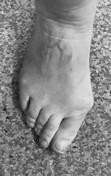
What problems can be expected?
The majority of people with toe problems manage however if the joints or toes become swollen, and hard skin (callus) can forms it can become painful.
What is the treatment?
Treatment is offered if the toes and or forefoot are causing pain or if it is reducing your ability to do your job or daily activity.
Medication
If you have regular pain, painkillers such as paracetamol or ibuprofen may help, please see your local pharmacist for advice.
Weight loss
Carrying extra pounds around your waist can put extra strain on your feet. Reducing your body weight can help, as it has been shown that you can reduced foot pain by losing just 5 pounds can improve foot pain.
Footwear
Wearing good footwear may help to ease symptoms of pain and discomfort. Finding wide and deep footwear is important and we acknowledge that this can be more challenging and there will be fewer styles to choose from or you may have to select shoes which you may not have typically chosen before. Manufacturers such as Rieker, Keller or DB typically make wider shoes.

Shoes with thicker soles can help such as fitflops, running style trainers or a walking style shoe or boot can help forefoot pain and protect the foot.
Footwear should fit correctly to avoid the toes rubbing and causing pain. The shoe should be wide and rounded at the front of the foot and deep enough for your toes to move freely. Avoid wearing shoes that make the problem worse, such as high-heeled, pointed or tight shoes. You may find that shoes with laces or straps are best, as they can be adjusted to the width of your foot. It is preferred that the shoe material is soft, stretches or is elasticated.
Lacing
Lacing the shoe differently can help create more room at the toe box. Missing out the lace holes at the end of the can create more width.
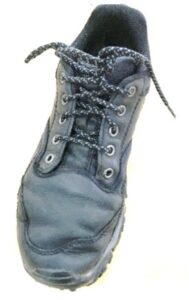
Shoe stretching
Leather can be stretched. A cobbler can stretch your shoes for you. You can also purchase shoe stretchers. Alternatively, placing damp newspaper in the toe to stretch out the end of the shoe or even with a potato, if done over-night or over a weekend, this can help stretch out the material.
Exercises
In a seated position, using an elasticated band:
Loop the band around the sole of the foot, gripping the loose ends with both hands. Ensure the band is tight.
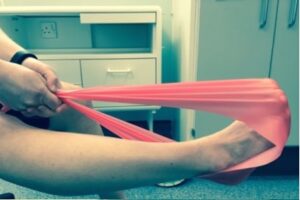
Keeping your foot still, curl the toes downwards
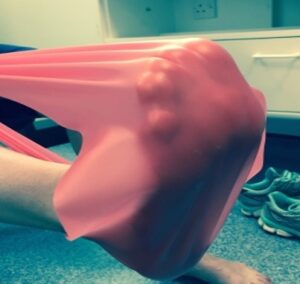
Slowly return to the start position
Frequency: 3 lots of 10, twice daily.
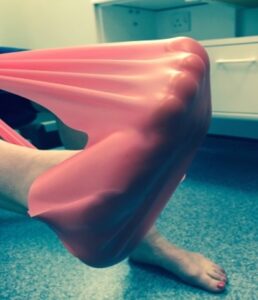
Intrinsic exercise theraband
Alternatively using a ball to exercise the toes can help. In this photo sequence, a soft small 8 cm ball is used. The balls are sometimes called hedgehog balls.
Exercise 1

Start by extending (bending up) your toes against the ball, whilst keeping the ball of your foot in contact with the ground. Hold this stretch for 10 seconds. Now roll your foot over the ball while gripping with your toes. (Your toes must maintain contact with the ball at all times. Repeat this exercise up to 10 times, 2 to 3 sets, as often as you like every 2 hours.
Exercise 2
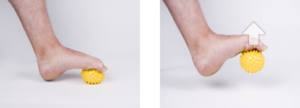
Practice picking the ball up with your toes until it feels tired to do so. This may be difficult at first but will become easier with practice. You can perform this exercise as often as you like, every 2 hours.
Foot arc exercise
Your podiatrist will be able to decide whether insoles are appropriate for you. Insoles can help to reduce your pain and allow you to function better.
Insoles take up more room in the shoe and sometimes lead to pressure onto toes. This means that insoles are not always helpful.
Steroid injections
A podiatrist can assess whether a steroid injection would be appropriate. Your podiatrist will explain what this would involve and what the risks and benefits can be. In most cases, a podiatrist can provide this injection.
Surgery:
Surgery will usually be considered once the foot has reached bony maturity (16 to 18 years old). A surgical referral depends on what has been tried (such as footwear), the stage of the bunion, pain levels and the long term impact on your quality of life. If surgery may be required, you podiatrist can arrange this onward referral for this opinion.
Back of heel
Achilles pain
Achilles pain
About tendonitis
Tendonitis is when a tendon swells (becomes inflamed) after an injury. It can cause joint pain and stiffness, and affect how a tendon moves. You can treat a mild tendon injury yourself and it should feel better within 2 to 3 weeks.
How to treat tendonitis yourself
Follow these steps for 2 to 3 days to help manage pain and support the tendon.
- Rest: Try to avoid moving the tendon for 2 to 3 days.
- Ice: Put an ice pack (or try a bag of frozen peas) wrapped in a tea towel on the tendon for up to 20 minutes every 2 to 3 hours.
- Support: Wrap an elastic bandage around the area, use a tube bandage, or use a soft brace. You can buy these from pharmacies. It should be snug, not tight.
It’s important to take a bandage or brace off before going to bed.
When you’re able to move the injured area without pain stopping you, try to keep moving it so the joint does not become stiff.
To help prevent further injury or pain, try to avoid:
- heavy lifting, strong gripping or twisting actions that make the symptoms worse
- playing any sport until the tendon has recovered
A pharmacist may be able to help with tendonitis
A pharmacist can recommend the best painkiller for you. Paracetamol and ibuprofen can help to ease pain.
They may also recommend an ibuprofen gel to rub on your skin.
Symptoms of tendonitis
There are tendons all over your body. They connect your muscles to bones in your joints, for example, in your knees, elbows and shoulders.
The main symptoms of tendonitis are:
- pain in a tendon that gets worse when you move
- difficulty moving the joint
- feeling a grating or crackling sensation when you move the tendon
- swelling, sometimes with heat or redness
If the pain is sudden and severe, and happened during an accident or activity, you may have torn (ruptured) a tendon.
You might have heard a popping or snapping sound when the pain started.
See a GP if:
- you have injured a joint and your symptoms do not improve within a few weeks
Treatment
Treatment for tendonitis
If you need treatment for tendonitis a GP may prescribe a stronger painkiller or suggest you use an ibuprofen gel on your skin to ease the pain.
If the pain is severe, lasts a long time, or your movement is limited, you may be referred for physiotherapy. You can also see a physiotherapist privately.
If physiotherapy does not help, you may be referred to a doctor who specialises in muscles and bones (orthopaedic specialist) or a local musculoskeletal clinic.
Some people with severe tendonitis may be offered:
- steroid injections, which may provide short-term pain relief
- surgery to remove damaged tissue or repair a ruptured tendon
Do
- warm up before exercising and gently stretch afterwards
- wear supportive shoes or insoles for exercise
- take regular breaks from repetitive exercises
Don’t
- do not overexercise tired muscles
- do not start a new sport without some training or practice
- do not do the same repetitive exercises
Inside ankle
Acquired flat foot (Fallen arch)
Acquired flat foot (Fallen arch)
What is acquired flat foot?
Feet start of flat and then the arches of the feet mature during mid-childhood. Just as everyone is of a different height, shape and size, feet are too. This means that some mature feet will always be flat whilst others may become flatter. This is commonly called a fallen arch or an ‘acquired flat foot’. There are different reasons why a foot may flatten, examples include injury, trauma, the aging process, weight gain, collagen disorders, some inflammatory conditions, diabetes and pregnancy.
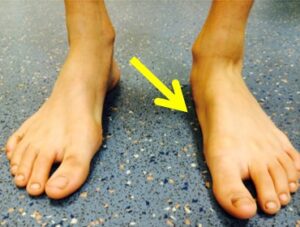
When feet become flatter, the main muscle and tendon responsible for maintaining the arch can become problematic. This main muscle is called tibialis posterior and it has a tendon which joins the muscle to the bones of the foot’s arch. When this muscle and tendon cannot carry out their normal task, this is called ‘tibialis posterior tendon dysfunction’. This condition is therefore associated with the term ‘acquired flat foot’.
What causes an acquired flat foot (fallen arch)?
It is usually an overuse injury though it can be the result of a specific trauma. With activities such as running and walking, small tears occur within the tendon more quickly than the body can repair them. This results in damage to the tendon which eventually becomes painful, swollen and weak.
Who is likely to get it?
Anybody can get a fallen arch, though you are more likely to suffer from it if the arches of your feet are already quite flat. The condition tends to be more common in overweight people, women and people over the age of 40. People who do a lot of walking or play high-impact sports are also more likely to experience problems. Other risk factors include diabetes and certain inflammatory conditions.
What are the symptoms of an acquired flat foot?
- Initially you may be aware of a discomfort and swelling behind the ankle and along the instep.
- The pain may become worse, particularly with increased weight-bearing. High-intensity or high-impact activities, such as running, can be very difficult. Some people can have trouble walking or standing for long periods.
- You may become increasingly aware of your foot becoming flatter or clumsy through time.
- You may begin to experience pain on the outside of your foot and ankle as the change in foot position places increased stress between the bones in this part of the foot.
- Typically, you may eventually find that, on the affected side, you are unable to stand on one leg and raise your heel.
- Unlike some other conditions, it does not usually resolve on its own but can progressively worsen over time. In rare cases, where the arch fully collapses, surgery may be the only treatment that can be offered.
How is acquired flat foot diagnosed?
The healthcare professional assessing your presentation will take a medical history and ask you questions about your symptoms. They will consider other reasons why you may be getting the pain.
Your foot and ankle will be examined to determine which structure is injured and whether it can still be moved back into the correct position. This is likely to involve you going onto tip toes, which checks strength, function, arch posture and if there is any discomfort.
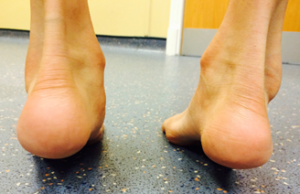
An ultrasound scan of your foot and ankle may be ordered to assist in the diagnosis and to help determine the extent of the presentation. Other investigations such as blood tests, an x-ray or MRI may sometimes be required.
What treatments can help?
Footwear
This can play a major role in recovery. Good quality walking boots that offer support both to the arch of the foot and around the ankle are recommended.
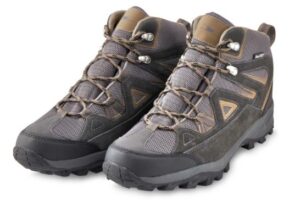
Rest
It is recommended that you avoid excessive standing or walking during recovery. You should stop high impact activities until the condition improves.
Foot orthoses (insoles)
These can help to reduce the stress that the injured tendon is exposed to. A podiatrist can provide foot orthoses modified to your specific needs.

Weight loss
Caring extra pounds around your waist can put extra strain on the arches of your feet. Reducing your body weight can help. For instance just loosing just 5 pounds in body weight has shown to improve foot pain.
Medication
Pain relieving medication such as paracetamol, or medication to help reduce inflammation such as Ibuprofen, can be helpful. It is best to consult a pharmacist or your clinician for advice on whether these are suitable for you.
Ice
This will help to reduce the pain and swelling. An ice pack, or ice, small pack of frozen vegetables wrapped in a towel is ideal (do not apply ice directly to the skin as this may cause an ice burn). Apply for 10 to 20 minutes. This can be repeated several times per day, though leave at least 2 hours between applications.
Ankle exercises
Specific exercises to rehabilitate and strengthen the damaged tendon can help you to return to your previous levels of activity. This intervention is recommended once the tendon has healed to a degree that will enable loading of the tendon without risk of further damage.
Ankle brace
This may be required if a level of support is required that cannot be gained from footwear and foot orthoses alone.
Surgical intervention
Most cases will resolve with the treatments explained above. Should the problem persist, surgery may be required. The surgical process is complex and carries risk. For this reason, surgical options are normally only considered if the symptoms have not improved after six months of strictly following appropriate advice and intervention.
Outside ankle
Ankle pain
Ankle pain
What causes ankle pain
There are many causes of ankle pain and an assessment is needed to determine this. Compared to other joints, the ankle rarely causes pain because the solid construction and its surrounding structures.
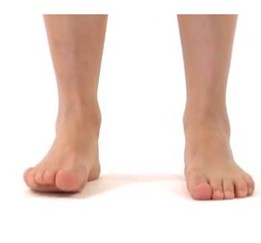
Typically, an injury (slip or fall), whether recent or in the past is responsible for ongoing ankle pain. Balance, strength and foot position can impact whether you have ongoing issues. Many commonly ongoing ankle pain is caused by damage to the soft tissues structures (tendons and ligaments). Less commonly ankle pain can be associated with bone and joint arthritic changes.
What are the symptoms of ankle pain?
- Pain that feels deep within the ankle.
- Movement of the ankle joint feeling restricted and stiffer.
- Pain when walking or being active.
- Pain in certain footwear, such as higher heels or in shoes with little, or no, support.
What treatments can help?
Medication
Pain relieving medication such as paracetamol, or medication to help reduce inflammation such as Ibuprofen, can be helpful. It is best to consult a pharmacist or your clinician for advice on whether these are suitable for you.
Rest
It is recommended that you avoid excessive walking and choose activities with less impact such as cycling or swimming.
Weight loss
Caring extra pounds around your waist can put extra strain on the arches of your ankles and feet. Reducing your body weight can help. For instance just loosing just 5 pounds in body weight has shown to improve foot pain.
Footwear
This can play a major role in recovery. Good quality walking boots that offer support for both the foot and around the ankle are recommended.

Ankle brace
This can offer a good benefit if the level of support required cannot be gained from footwear and foot orthoses alone.

Ankle exercises
Most ankle pain responds well to movement. The following exercises may be helpful in improving your painful symptoms. The exercises should not cause you more discomfort than you have been experiencing. Non-weight bearing exercises are recommended first and if these are well tolerated, then progressing to weight bearing exercises can be tried.
Exercises
Ankle circles
Sit on the floor or a chair with your leg in front of you. With your toes pointed away from you, draw a big circle with your toes. Do 5 to 10 circles in each direction, at least 3 times per day.
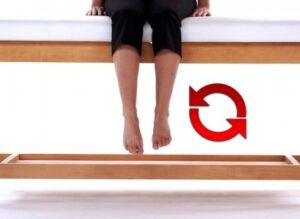
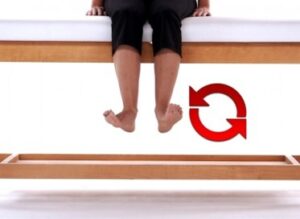
Alphabet letters
Imagining your big toe as a pencil, try to write the letters of the alphabet in the air. You can alternate between uppercase and lowercase. Aim to do this 2 or 3 times a day.
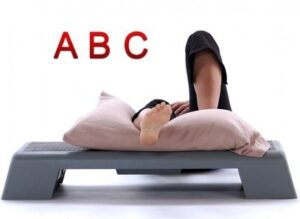
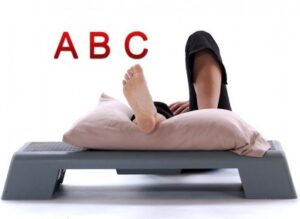
Pull toes up or point toes down
With your knee straight, pull your toes towards your head, hold for 15 seconds, then point toes away from you. Hold for a further 15 seconds. Repeat this 10 times in both directions. Aim to do this 2 to 3 times a day (see below).

Turn foot in or turn foot out
Turn the bottom of your foot inwards as far as you can and hold this position for 15 seconds. Now turn the bottom of the foot outwards as far as you can and again hold for 15 seconds. Do this 10 times in both directions. Aim to do this 2 to 3 times a day (see above).
Calf Raises
In standing position, push up onto tip toes and lower steadily. Repeat 10 times. Perform 3 sets twice a day.
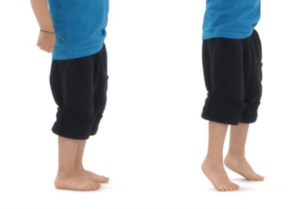
Calf stretches
Standing in a short stride position, keep the back leg straight and bend the front knee until you feel tightness down the back of your calf. Hold for 30 seconds. Repeat 5 times. Change you position to the other side and repeat programme.
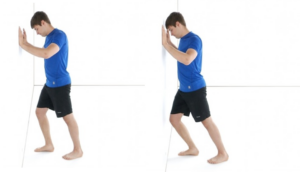
Further intervention
Ankle pain can be persistent due to ongoing arthritis and bony changes. Factors such as your age, strength, balance, body weight, smoking, compliance to the treatment programme and your general health status will affect this.
If you are still experiencing significant pain and swelling it may be necessary for you to have your ankle reassessed and we may recommend a steroid injection which we can offer you. In certain cases, it may be that a steroid injection is offered at the same time as doing a scan of your ankle. If this is thought to be necessary, we can arrange this for you. If your ankle pain is not improving, we may need to consider arranging further investigations such as an x-ray or a scan.
Standing heel raises video
Ankle sprain
Ankle sprain
What is a sprained ankle?
Ligaments are strong bands of tissue that help to support and stabilise joints by connecting one bone to another. Ligaments on the outside of the ankle are most commonly injured when they get overly stretched, twisted or torn when the foot rolls outwards. This type of injury is called an ankle sprain. Common reasons why this can occur include walking on uneven surfaces, stepping awkwardly in high heeled shoes, jumping from a height or playing sport. This is a very common injury with an estimated 5000 cases per day in the UK. Most cases will improve within 6 to 8 weeks. You are at a higher risk of an ankle sprain if it has happened before. Following specific advice can help in the recovery process and can reduce the chances of it happening again.
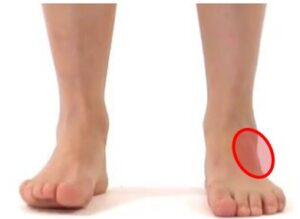
Symptoms of a sprained ankle
If you have sprained your ankle it is likely that you will experience the following:
- Pain: Particularly with movement of the ankle, standing or walking.
- Inflammation: The swelling will occur quite soon after injury.
- Bruising: This may take hours or even days to appear.
- Restricted mobility: you may find it difficult initially to undertake your normal day-to-day activities, including walking.
Treatments of a sprained ankle
Inadequate or lack of treatment following an ankle sprain can lead to chronic problems such as decreased range of motion, pain and ankle joint instability. It is therefore recommended that you adhere to these treatment guidelines. The immediate goals of treating ankle sprains are to reduce the pain and swelling and to protect the ankle from further injury. An aim is also to be able to regain normal use of the ankle as quickly as possible. You may need your an x-ray if there are concerns that you may have broken your ankle.
Self-managing a sprained ankle
- Protect your ankle from further injury. To achieve this, footwear should be comfortable, feel stable and you should feel confident to walk in them, this may be a lace-up shoe with supportive high sides or walking boot.
- Rest your ankle for the first 2 to 3 days. Limit your level of weight- bearing. Your health professional may suggest the use of crutches. Do not attempt to continue playing sports or walking long distances.
- Ice application will help to reduce the pain and swelling. An ice pack or ice, small frozen vegetables wrapped in a towel is ideal (do not apply ice directly to the skin as this may cause an ice burn). Apply for 10 to 20 minutes. This can be repeated several times per day for the first 2-3 days, though leave at least 2 hours between applications.
- Compression by way of elastic bandage is commonly recommended to help minimise initial swelling. Recent research suggests that a lace-up or semi-rigid supports can be beneficial in aiding return to normal function.
- Elevation, a further way to help minimise swelling is to keep your foot elevated as much as possible. When seated, ensure that your foot is kept higher than your hip. When lying, place a pillow or cushion under your foot.
- Avoid Harm:
H : Avoid applying heat such as hot water bottles, hot baths, heat packs as this will increase the blood flow to the ankle and will cause an increase in swelling or inflammation. A : Alcohol should be avoided as this can lead to increased swelling by increasing the blood flow to the ankle. R : Avoid running, or any other form of high impact activity, as this can cause further damage. This should be for at least 3 to 4 weeks and will depend upon which sport you wish to return to. There should be a phased return and your health professional can work with you in developing a rehabilitation programme specific to your sport. M : Massage can increase swelling so it is best avoided for the first 2 to 3 days - Medication: Paracetamol can be very effective at easing the pain. It is best taken regularly throughout the day for a few days rather than taking now and again. Follow the information provided with your medication. After a week, anti-inflammatory medication, such as Ibuprofen, can help reduce pain and swelling. This type of medication can have side effects and is therefore not recommended for everyone. It is best to consult your GP or a pharmacist before taking. Your doctor may prescribe codeine if they feel it is necessary.
Exercises to help your sprained ankle 3 days after injury
Exercises to restore function and strength usually begin 48 to 72 hours following the injury. Studies have shown that this treatment can enable a quicker return to normal activity levels.
Ankle circles
Sit on the floor or a chair with your leg in front of you. With your toes pointed away from you, draw a big circle with your toes. Do 5 to 10 circles in each direction, at least 3 times per day.


Alphabet letters
Imagining your big toe as a pencil, try to write the letters of the alphabet in the air. You can alternate between uppercase and lowercase. Aim to do this 2 or 3 times a day.


Pull toes up or point toes down
With your knee straight, pull your toes towards your head, hold for 15 seconds, then point toes away from you. Hold for a further 15 seconds. Repeat this 10 times in both directions. Aim to do this 2 to 3 times a day.

Turn foot in or turn foot out
Turn the bottom of your foot inwards as far as you can and hold this position for 15 seconds. Now turn the bottom of the foot outwards as far as you can and again hold for 15 seconds. Do this 10 times in both directions. Aim to do this 2 to 3 times a day.


Calf raises
In standing position, push up onto tip toes and lower steadily. Repeat 10 times. Perform 3 sets twice a day.
Calf stretches
Standing in a short stride position, keep the back leg straight and bend the front knee until you feel tightness down the back of your calf. Hold for 30 seconds. Repeat 5 times. Change you position to the other side and repeat programme.
Standing heel exercise
Further intervention
You should expect your ankle to be significantly better after about 6 to 8 weeks though some will take longer to heal than others. Factors such as your age, the severity of your injury, compliance to the treatment programme and your general health status will influence the healing rate.
If you are still experiencing significant discomfort after 6 to 8 weeks, it may be necessary for you to have your ankle reassessed. Sometimes there may be a torn ligament or small fracture that is not always possible to detect shortly after the injury due to the level of swelling and pain. Your doctor or health professional may recommend a scan of your ankle or an x-ray, even if you already had one initially after the injury.
Prevent further ankle sprains
Adhering to the rehabilitation advice, particularly the balance exercises, has been shown to help prevent further ankle sprains. It is advisable to wear boots with stiff uppers such as a sturdy walking boot when you are walking long distances, particularly over uneven terrain. You may benefit from wearing a lace-up or semi-rigid ankle support for high impact sporting activities, particularly if there is a previous history of ankle sprains.
Other foot conditions
Gout
Gout
Gout is a type of arthritis that causes sudden, severe joint pain. Painkillers can help the pain and healthier lifestyle choices can prevent future attacks.
Symptoms of gout
The main symptoms of gout are:
- sudden severe pain in a joint, usually your big toe, but it can be in other joints in your feet, ankles, hands, wrists, elbows or knees
- hot, swollen, red skin over the affected joint, redness may be harder to see on black or brown skin.
See a GP if:
- you have symptoms of gout for the first time
- you have gout and your usual treatments are not helping
An attack of gout usually lasts 1 to 2 weeks if left untreated. If you do not get treatment, future attacks may last even longer. Leaving gout untreated may cause lasting damage to joints.
Ask for an urgent GP appointment or get help from NHS 111 if:
You have a sudden pain and swelling in a joint and:
- the pain is getting worse
- you also have a very high temperature (you feel hot and shivery)
- you also feel sick or cannot eat
These symptoms could mean you have an infection inside your joint and need urgent medical help.
You can call 111 or get help from 111 online.
What happens at your appointment
The GP may ask about your diet and if you drink alcohol if you have symptoms of gout.
They may also do a test to measure how much uric acid is in your blood. Uric acid is a chemical that can lead to crystals forming around your joints which cause pain.
If the test is still unclear, a GP may refer you to see a specialist (rheumatologist) and arrange further tests.
This could include taking a sample of fluid from inside the affected joint, using a thin needle. If this test cannot be done or the diagnosis is still unclear, then a scan will be arranged.
Please complete the referral form and once you have completed the form, please email the form and the photo to the Podiatry department on leedscommunitypodiatry@nhs.net
Treatments for gout
Treatment for gout attacks
Attacks of gout are usually treated with a non-steroidal anti-inflammatory (NSAID), like ibuprofen.
If the pain and swelling does not improve you may be given steroids as tablets or an injection.
Treatment to prevent gout coming back
Gout can come back every few months or it may be years. It can come back more often if it’s not treated.
If you have frequent attacks or high levels of uric acid in your blood, you may need to take uric acid-lowering medicine.
Important
It’s important to take uric acid-lowering medicine regularly, even when you no longer have symptoms.
Things you can do to help a gout attack
If you’re having a gout attack, there are things you can do to relieve the pain:
Do
- take any medicine you’ve been prescribed as soon as possible, it should start to work within 2 days
- rest and raise the limb
- keep the joint cool, apply an ice pack, or a bag of frozen peas, wrapped in a towel for up to 20 minutes at a time
- drink lots of water (unless a GP tells you not to)
- try to keep bedclothes off the affected joint at night
Don’t
- do not put pressure on the joint, this can make the pain feel worse
Who gets gout
Gout is caused by having too much uric acid in your blood. This can lead to crystals forming around your joints, which causes pain. It sometimes runs in families.
It’s more common in men, especially as they get older.
You might have a higher chance of getting gout if you:
- are overweight
- drink alcohol
- have been through the menopause
- take medicines such as diuretics (water tablets), or medicines for high blood pressure (such as ACE inhibitors)
- have high cholesterol, high blood pressure, kidney problems, osteoarthritis or diabetes
- have had surgery or an injury
Things that can trigger a gout attack
You might get a gout attack if you:
- have an illness that causes a high temperature
- drink too much alcohol or eat a very large meal
- get dehydrated
- injure a joint
- take certain medicines
Get treatment immediately if you feel an attack starting.
Things you can do to help prevent gout coming back
Making healthy lifestyle choices may mean you can stop or reduce further gout attacks:
Do
- try to lose weight if you are overweight, but avoid crash diets
- eat a healthy diet, your doctor may give you a list of foods to include or limit
- have some alcohol-free days each week, try not to drink more than 14 units of alcohol a week
- drink plenty of fluids to avoid getting dehydrated
- exercise regularly, but avoid intense exercise or putting lots of pressure on joints
- try to quit smoking
- ask a GP about vitamin C supplements
Don’t
- do not have lots of sugary drinks and snacks
Complications of gout
If you get repeated attacks of gout over a long period of time (chronic gout), and are not treated it can lead to:
- damage in your joints
- hard lumps, called tophi, under your skin, usually on your ears, fingers or elbows, they can be painful and have an impact on your daily life
- kidney stones
- chronic arthritis, but this is rare


